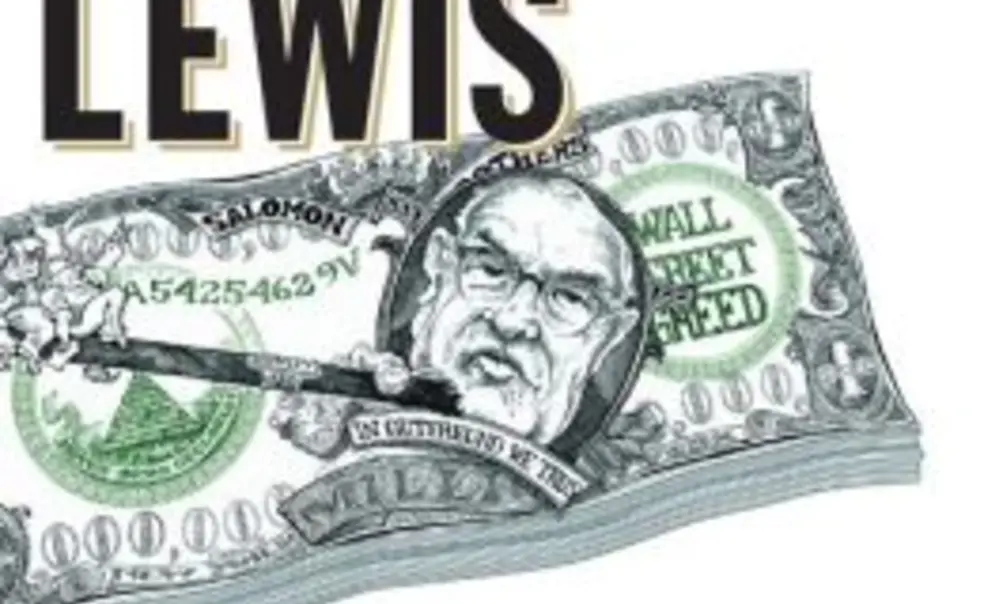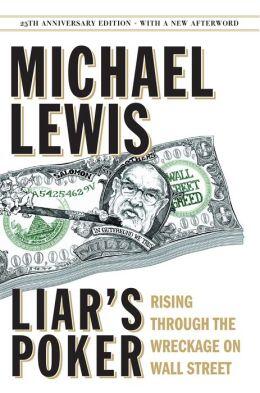A Game of Private Profit at Public Risk
LIAR’S POKER: RISING THROUGH THE WRECKAGE ON WALL STREET, by Michael Lewis ’82 (W.W. Norton)
The following story was published in PAW’s Feb. 21, 1990, issue.
Can an art-history major from Princeton who recklessly eschewed the economics department’s Econ 201 (Introduction to Financial Economics), Econ 318 (Corporation Finance), and Econ 333 (Accounting) nevertheless land on his feet at Wall Street’s Salomon Brothers, there to become what is celebrated at that firm as a “Big Swinging Dick”?
Apparently so, if we believe Michael Lewis ’82’s Liar’s Poker, a marvelously entertaining and enlightening tale about life at Salomon Brothers during the roaring 1980s.
Lewis’s adventure begins with an invitation to sup with England’s Queen Mother at a fundraiser pitched to some eight hundred insurance salesmen and other practitioners of high finance. Displaying the Princetonian’s natural graces — intellect, wit, and endless charm — he so impresses the wife of a managing director at Salomon Brothers that he soon finds himself transported, as a trainee at Salomon Brothers, from the lowly status of Mensch to that of “Geek,” a freshly minted but unseasoned bond trader. With the rank of Geek, Lewis joins the firm’s office in London, where he quickly progresses to the exalted status of Big Swinging Dick — a trader who, with a phone call or two, earns million-dollar profits for the house of Salomon Brothers, however the deal is done.
Bond traders live off the “spread” between the prices at which they buy bonds from one party and resell them to another. In a well-functioning securities market, in which all participants can properly evaluate the pieces of paper being traded, competition will make this spread paper-thin. To make a good living, therefore, a bond trader must have a reliable clientele and move large volumes of money. Handsome rewards from such trading would be well earned, however, because bond traders provide the liquidity in the secondary securities markets without which a modern market economy would languish. Properly deployed, a bond trader is anything but a parasite.
Alas, Lewis’s tale suggests that the financial markets are still a tad shy of this ideal. In many instances, the traders are better informed than are their clients, an asymmetry that can and is used to the traders’ advantage. In one of the book’s more tragicomic passages, for example, Lewis explains how he, a mere Geek, succeeded in dumping onto a not-so-nimble German banker some A.T.&T. bonds that Salomon Brothers owned and desperately sought to cast off. Lewis assured Herman, the German, that these bonds were undervalued, but shortly after their transaction, Salomon Brothers stood ready to repurchase these bonds from Herman, only at a much lower price — a posture that elicited from poor Herman a predictable “Teutonic scream.” Herman, his pregnant wife, and his baby were even less charmed when the Austrian bank that employed him summarily fired him, after the bank’s loss on that trade had mounted to $140,000.
You feel sorry for Herman, although, in truth, he had every opportunity to defend himself against Lewis the Geek. Indeed, Herman’s plight pales before that of the helpless American taxpayer on whom Salomon Brothers was permitted to feast, courtesy of a handful of “Honorable” so-and-sos in the United States Congress who feed upon the Savings and Loan industry’s PAC money and who, in turn, feed that industry with taxpayers’ money. This sorry tale is told in Lewis’s otherwise entertaining chapter “The Fat Men and Their Marvelous Money Machine.”
During the 1970s, the S.&L. industry lent billions of dollars against long-term mortgages written at fixed interest rates of between 7 and 10 percent. But at the double-digit interest rates prevailing in the early 1980s, these mortgage bonds had market values of somewhere between sixty and eighty cents per dollar of book value. In 1981, at the behest of the S.&L. industry, Congress passed legislation that allowed S.&L.s to claim immediate tax refunds for up to the last ten years of taxes on the basis of book losses from the sales of such mortgage bonds. At the same time, the S.&L.s were allowed to amortize these book losses over the next thirty years in their reports to shareholders. For example, in 1982, an S.&L. with $1 billion of outstanding mortgages on its books could sell these for, say, $650 million, immediately claim a huge tax refund on the $350 million book loss, but report to shareholders a loss of only $11.7 million ($350 million divided by thirty years) for the year.
Better still, the $650 million in proceeds from the sale of such bonds could immediately be reinvested, either in similar mortgage bonds that other S.&L.s were dumping for the same reasons, or in all manner of high-yield, high-risk deals that Congress permitted the industry to underwrite under the banner of “deregulation.” Of course, to be fully responsible toward the S.&L.s’ depositors, the Honorable so-and-sos also raised the deposit guarantees for S.&L.s from $40,000 per account to $100,000 per account, making you and me — the taxpayer — the ultimate fall guys for whatever mistakes the swashbuckling and often ill-trained S.&L. managers might make. It was a game of private profit at public risk, with PAC-money profit sharing by the Honorable so-and-sos.
You need not have a Ph.D. in economics to predict the feeding frenzy that such a game is likely to unleash. Any two S.&L.s now could jointly suck millions of dollars in tax refunds out of the Federal Treasury simply by swapping mortgage bonds on their balance sheets. Salomon Brothers’ bond traders, ever in the nation’s service, were only too eager to help the S.&L.s fulfill the will of Congress — at awesomely handsome spreads, to be sure. And thus it was that Geek traders in their mere twenties, busily swapping bonds for America’s leading losing industry, could easily reap for Salomon Brothers annual profits in the range of $30 to $50 million, all the while feeling cruelly exploited by bosses who paid them the mere pittance of three to five times the average annual income of American physicians! Where was Karl Marx when there exploited ones needed him?
It is not clear how representative Lewis’s fabulous tales are of Salomon Brothers in particular, or of the financial markets as a whole. Nor is it obvious what lessons we should draw from the tale.
In the popular press, the book has nourished the widely held thesis that greed was the essential hallmark of the 1980s, and that we must turn away from greed to make Wall Street (and America) wholesome again. In an introspective review of Goldman, Sachs & Company’s operations that appeared in the New York Times, for example, a senior partner of the firm complained about the “generation gap in values” at the office, specifically the “greed displayed by some employees.” You are made to believe that the world of high finance is like a giant cookie factory in which those who knead the dough have traditionally had the inbred integrity to partake of that dough only in respectably moderate doses. Sometime during the early 1980s, so goes the story, that cookie factory was invaded by a bunch of young, hungry, amoral parasites who partook of that dough not only with their pinkies but with both hands, and both feet to boot. On the basis of this thesis, you might think of Salomon Brothers’ bond traders simply as a bunch of young rascals who came and now have gone, leaving the firm once again in the hands of the gray-haired types of the old school.
Perhaps it is so; but I find that story implausible. It is hard to believe that the now gray-haired folks who joined high finance decades ago ever gravitated thither for reasons other than to amass the greatest personal wealth possible. Likely as not, what distinguishes the 1980s from earlier decades is not the degree of greed that drove the financiers, but the setting in which they sought their fortunes.
In the good old days, Wall Street was a gentleman’s (yes, gentleman’s) club with carefully rigged economic turfs and rigidly rigged fees and commissions. In that genteel, rigged setting, a gentleman could do very well - indeed, largely by doing good. During the late 1970s and the early 1980s, the walls around the various club chambers were torn down as part of the general “deregulation” fever then sweeping the nation. As a result, both the young and the old on Wall Street found themselves thrust into a highly competitive free-for-all whose new rules the legions of players in these markets understood only to varying degrees. In this new situation, the quick-witted among the players — many of them very young — could fleece the slower-witted, and among the latter were Herman the German and legions of John and Jane Q. Publics. Characteristic of the quick-witted is Liar’s Poker itself, a game of bluff in which, after fabulous wagers, Lewis’s colleagues attempt to guess the serial numbers of dollar bills.
Adam Smith’s dictum that, in a freely competitive world, private avarice will always sum to the common good may have been relatively more valid in the context of the pin factories that nourished his imagination. In our complex, modem world, however, large private fortunes can easily be extracted by clever folks from less-clever folks through imaginative zero-sum or negative-sum games. As I so often tell my students at Princeton: “You may become engineers, physicians, or product entrepreneurs who earn your income as a reward for contributing to the welfare and prosperity of society as a whole. If you do and are successful, you will typically earn between $100,000 and $150,000 or so a year. On the other hand, you may also join that ever-growing corps of income redistributors — tax experts, legal experts, regulatory experts, financial wizards, lobbyists, legislators, and so on - who use so much of their time and intellect not to create net social value added, but merely to redistribute toward themselves and their clients claims to the useful production of others. You can easily earn in the high six or seven figures in these zero- or negative-sum games, without doing anything good for society as a whole.”
According to Lewis, Salomon Brothers had heavily moved into the redistributive mode during the roaring 1980s and so, surely, did many other august firms on the Street. In the Epilogue to his book, Lewis suggests that he left the firm in 1988 because he yearned for an income from net social value added rather than from net social value redistributed. His book certainly is a good start on that road.
I am not persuaded, however, that the people he left behind will ever be much troubled by that distinction. We shall see in the decade ahead. My bet is that the Street will continue to have at its core highly productive people who channel investible funds fairly efficiently from savers to borrowers. But around these genuine value-adders there will continue to be that large and possibly growing coterie of quick-witted redistributors — folks who will go on inventing ever-new versions of Liar’s Poker as they help America to de-lever the leverage they helped put in place during the 198Os, to pick through the rubble of bankruptcies left by that game, somehow to “restructure” whatever is now “structured,” to diversify what is now consolidated, to consolidate what is now diversified, and, wherever feasible, to do it all at the same time. And Congress, for its part, and in return for PAC nourishment, will construct for these people ever more wondrous “money machines,” as the shelf that was swept bare by the Tax Reform Act of 1986 is restocked with a fresh set of tailor-made tax gimmicks designed mainly to nourish the nation’s redistributors. As Yogi Berra, or Voltaire, or whoever once put it, “Plus ça change, plus c’est la même chose.” Right on!
Uwe Reinhardt is the James Madison Professor of Political Economy at the Woodrow Wilson School and, at the time of this story’s publication, was a regular contributor to PAW.
Brooke Shields ’87 Recalls Princeton Days in New Memoir
Love Beads and Leopard-Print Bikinis: Novel Portrays Coming of Age in the ’70s
Seeing the World: Jonathan Calvert ’53 Explores Six Continents














No responses yet